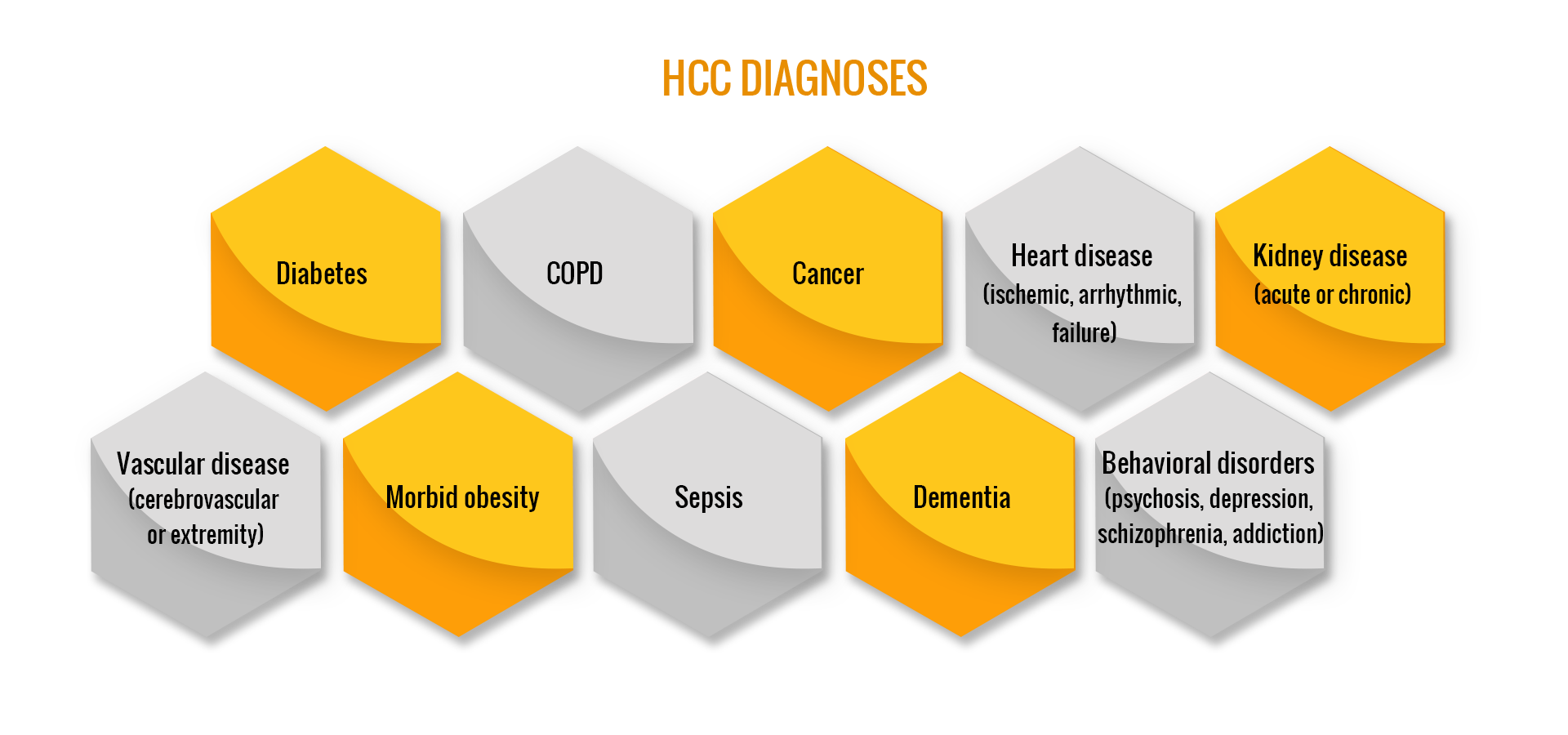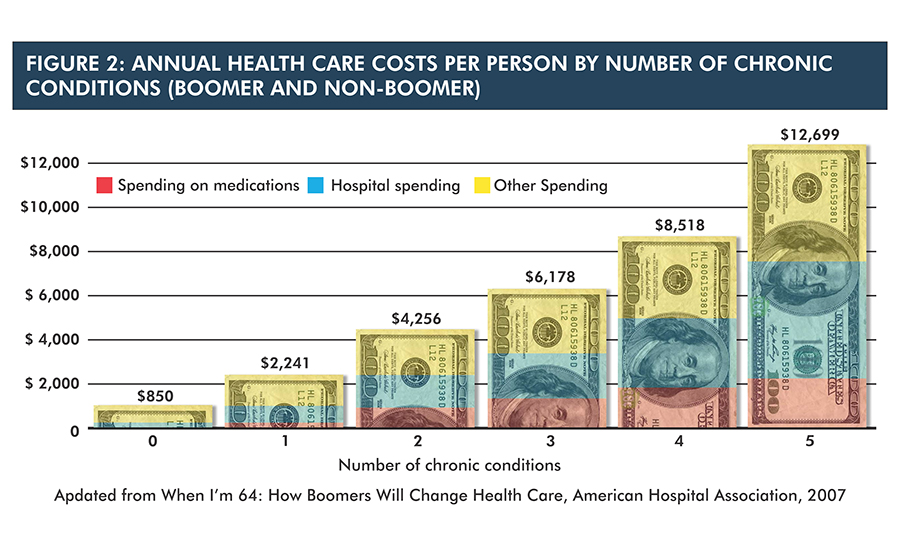Proper Coding And Top HCC Diagnoses
According to the Centers for Disease Control and Prevention (CDC), chronic disease is responsible for seven of ten deaths each year, and treating people with chronic diseases accounts for 86% of our nation’s total healthcare costs. It is apparent that preventing chronic diseases, or managing symptoms when prevention is not possible, can reduce these costs.
The top 10% of the population accounted for 64.9% of total healthcare expenditures with an annual individual mean expenditure of $28,808. With HCC (Hierarchical Category Conditions) patients costing two to five times more than other groups of populations, the ability to offer cost effective care management solutions is key.
This rising-risk group is not yet sick enough for expensive clinical care, and they are past the point where preventative solutions are effective. This is the care gap.
| Major HCC Dx | Stats to Support Our Need to Focus on These HCC Dx |
|---|---|
| Heart Disease / Stroke | Heart disease/stroke account for 859,000 deaths every year and costs healthcare systems $199 billion/year with $131 billion on lost job productivity |
| Cancer | Cancer diagnoses affect >1.6 million people and almost 600,000 die from it, making it the second leading cause of death. The cost of cancer care is expected to reach $174 billion by 2020 |
| Diabetes Mellitus (DM) | About 30 million people have DM and another 84 million adults have pre-diabetes. DM can cause heart disease, kidney failure and blindness and costs our healthcare systems/employers $237 billion/year |
| Morbid Obesity | Morbid obesity affects 1 in 5 children and 1 in 3 adults, putting people at risk for DM, heart disease and some cancers. Twenty five percent of those aged 17-24 are too heavy to join the military. This diagnosis costs our healthcare systems $147 billion/year. |
| Alzheimer's Disease | Alzheimer’s is a type of dementia that is an irreversible, progressive brain diagnosis affecting 5.7 million people. It is the 6th leading cause of death among all adults and the 5th leading cause of death for those 65+. By 2040, these costs are projected to jump to between $379 and $500 billion annually. |
| Epilepsy | Three million adults and 470,000 children and teens under 18 have active epilepsy. Epileptic patients report worse mental health, more cognitive impairment and barriers in social participation. Healthcare costs for a person with epilepsy are $10,200 - $47,900/year. |
It's important to examine some of the major HCC (Hierarchical Category Conditions) chronic conditions to understand why coders need to focus on them. HCC diagnoses (dx) codes are chronic conditions recognized by the CMS as being associated with high medical costs and, by focusing on them, can help capture lost revenue dollars while identifying areas of revenue risk.
The most current list of the top HCC diagnoses which should be the focus of teaching and training include:

The number of individuals with disorders is likely to increase further in view of the aging of the population and worsening social problems. This growing burden amounts to a huge cost in terms of human misery, disability, and economic loss.
Reasons for the high costs associated with these chronic conditions include
-
Chronic Diseases - Chronic illnesses such as heart disease, stroke, lung and kidney disease, cancer, diabetes, epilepsy, and Alzheimer’s account for the majority of healthcare spending in the US. According to the CDC, six in ten adults in the U.S. have a chronic disease, and four in ten have two or more.
-
Diabetes - The Southeast and Midwest contain the most patients with diabetes (841,000 and 643,000, respectively), which may be a result of higher obesity rates or aging populations in these geographies, and in rural populations with little access.
-
Aging Baby Boomer Population - Baby boomers are the nation's largest living adult generation, and they are moving toward retirement at a rapid pace. Around 10,000 baby boomers turn 65 each day and are exiting the workforce at a strong and steady pace, now known as the "silver tsunami." If this rate continues, the influx of 78 million aging Americans will result in Medicare spending increasing by 8 percent by 2035, and 15 percent by 2080.
-
Provider Shortages - The United States will see a shortage of up to nearly 122,000 physicians by 2032, according to data published by the AAMC (Association of American Medical Colleges). This is partly because 55 percent of all registered nurses and 52 percent of the active physician workforce are 55 or older.
The Importance of Proper Coding
With the current health problems only continuing to escalate, it is of utmost importance for coders to abstract chronic diagnoses correctly from the patient record. Organizations such as the CDC and the WHO need this information to keep track of illness, costs, trends, etc. to better prepare financially for chronically ill patients. It further substantiates our responsibility to continually provide training and updates to our coding team so we are part of the solution and not perpetuating problems that already exist.
Looking Forward
With an aging population that continues to grow, our health care system will be changed forever. Are we ready for it? According to the Global Health and Aging report presented by the World Health Organization (WHO), “The number of people aged 65 or older is projected to grow from an estimated 524 million in 2010 to nearly 1.5 billion in 2050.”
This leads to the question “What are the implications of the aging population on health care?” We have all heard the term “baby boomer.” According to the Office of Disease Prevention and Health Promotion, the first Baby Boomers turned 65 in 2011. By 2030, it is projected that more than 60% of this generation will be managing more than one chronic condition. That’s one of many reasons to stay focused on the top HCC and proper coding.

